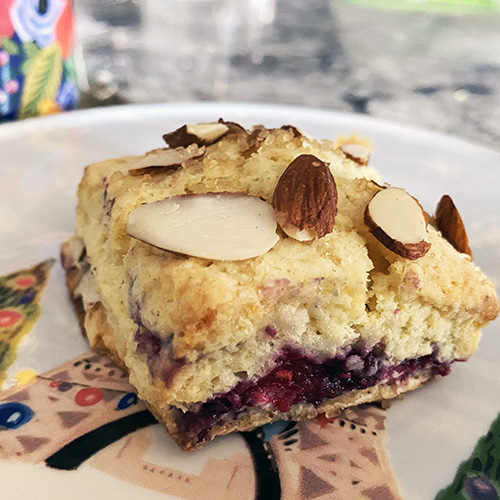Master Scone Recipe
based on: Williams Sonoma and The Zuni Cafe Cookbook by Judy Rodgers
Brilliant scone recipe, derived from Judy Rodger’s basic template from Zuni Cafe.
-
255 g (2 cups) all purpose flour
-
50-60 g (¼ cup) sugar
-
1 tablespoon baking powder
-
½ teaspoon salt
-
1 stick cold butter, cut into ~ ½ inch chunks
-
1 egg
-
¼ - ½ cup heavy cream, cold
-
Preheat the oven to 350 °F.
-
Make sure to keep all ingredients as cold as possible throughout and work the dough as little as possible to avoid building up gluten.
-
Mix the flour, baking powder, salt, and sugar together.
-
Add the chunks of cold butter and coat with the flour mix. Using a pastry cutter, blend the flour / butter together until you have pea-sized chunks. If you don’t have a pastry cutter, you can use two knives or your hands. Other people use food processors, which makes it simple but can build up excess gluten, leading to tougher scones.
-
Mix together the egg with ¼ cup of cold heavy cream.
-
Add the cream/egg and mix with your hands till you have a loose dough, adding more cream as needed. At the end, the dough should be soft and completely together without dry spots but should not be sticky– think a little bit stiffer than Play-doh consistency. Typically, I add most of the ¼ cup of cream/egg mixture and blend by hand and slowly dribble in more cream until the consistency feels right. That’s often close to an additional ¼ cup of cream, for ½ cup total. Avoid kneading the dough; you want to work it as little as possible.
-
If you want to laminate the dough, roll out or press the dough and fold over itself a few times to create flaky layers like a biscuit (see raspberry almond variation).
-
Roll out or press by hand to ~ 1 inch thick and cut into squares, rounds, or triangles.
-
If you have time, refrigerate or freeze the scones for 15-30 minutes before baking to ensure the butter is cold to get maximal flakiness.
-
Sprinkle the scones with demerra sugar or similar and bake ~ 20-25 minutes until slightly golden on the edges.
-
Unbaked scones can be stored in the freezer and baked à la minute as needed.
-
Add ⅓ cup crystallized ginger, chopped, to the butter/flour/sugar mixture with the cream/egg addition. Mix to combine and bake as usual.
-
After forming the dough, sprinkle with flour on both sides and roll out to ~ ½ cm thick.
-
Sprinkle the dough with almonds and ~ 1 cup of frozen raspberries.
-
Fold the dough in thirds, enveloping the berries and nuts. Where possible, try to make sure the raspberries are tucked in, lest they’re on the edges of the scone, where their juices will caramelize and burn in the oven.
-
If you want to top with almonds, baste with egg wash or cream and sprinkle with almonds and sugar (otherwise they won’t stick).
-
Follow the procedure for raspberry almond scones, omitting the almonds and adding 1 cup of frozen fruit.
-
If using peaches, cut them into chunks. Cherries should be halved.
-
Fresh fruit should be frozen before mixing to maintain their integrity.
-
1 teaspoon of lemon zest can be added to the dry ingredients.
-
(optional) Add the zest of a ~ ¼ to ½ lemon to the sugar and rub to release the lemony oils. Add to the flour/baking powder.
-
Increase the sugar to 70 g.
-
Mix the dough as usual.
-
Roll rhubarb chunks in a bit of sugar to offset their special tartness.
-
Roll out the dough, add a layer of sugary rhubarb, and then an optional layer of frozen strawberry chunks. Laminate, cut, and bake as usual.
-
The rhubarb will start weeping from the sugar, so work quickly and/or work with frozen rhubarb. It’ll also take slightly longer to cook, since the fruit releases more moisture than other fruits.
-
Add the zest of a lemon to the sugar and rub to release the lemony oils. Add to the flour/baking powder.
-
Increase the sugar to 60 - 70 g.
-
Mix the dough as usual.
-
Incorporate frozen blueberries like with the raspberry almond method (roll out, laminate into the middle).
-
Add ~ 1 teaspoon of cinnamon to the flour mix before cutting the butter in. Note: I haven’t made this variation in awhile, so this is just a rough estimate of how much cinnamon to add. Add what looks right.
-
Sprinkle with cinnamon sugar before baking.
Basic recipe
Variations
Ginger scones
Raspberry almond scones
Fruit scones
Rhubarb or strawberry rhubarb
Blueberry lemon
Cinnamon scones
Notes
Modifications
-
I tend to use ~ double the amount of cream from the original recipe, to avoid overworking the dough and kneading it to have it come together. As a result, they tend to softer and moister, but also richer.

Always work cold: cold butter, cold cream, cold eggs, cold/frozen fruit. This helps keep the scones tender and flaky.
Freezing the fruit is a suggestion from the Tartine cookbook. When working with fresh fruit — especially moist fruits like strawberries and peaches — they can start to prematurely sweat and add moisture to the dough, which makes it sticky. Frozen fruit avoids this problem and makes sure the butter doesn’t melt till it’s in the oven.
Avoid working the dough very much; overworking leads to gluten, which makes the scones tough.
I mix by hand to find the right consistency; they should be a soft but dry dough, of the consistency of fresh Play-doh. They shouldn’t feel dry, nor should they feel sticky.